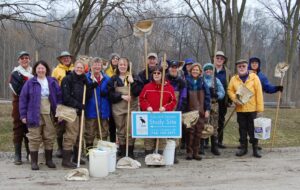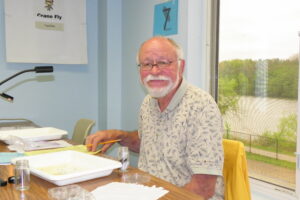HRWC is celebrating 30 years of River Roundups, our macroinvertebrate monitoring program! In 1992, a group of pioneering staff and volunteers first stuck their nets into flowing water and dumped debris into white pans, sorting for benthic macroinvertebrates. This established a legacy of volunteer science that has since spread across Michigan, engaged thousands of people, and greatly expanded knowledge of the Huron River watershed.

The initial concept of volunteer engagement with the Huron River started with HRWC staff member Scott McEwen. He wanted to start an initiative that produced “random acts of kindness to the river” and was considering ideas like trash cleanups or organized events. HRWC Executive Director Paul Rentschler and staffer Dr. Joan Martin suggested the concept of an “Adopt-a-Stream” program that included volunteers monitoring water quality. Janis Bobrin, the Washtenaw County Drain Commissioner, provided funding to get the project moving. Dual-funded by HRWC and the Drain Commissioner, Joan took the reins and set up the structure for the monitoring program we know today. Janis continued to support Joan’s position for the next 20 years; even today the Washtenaw County Water Resources Commissioner provides funding for HRWC’s macroinvertebrate program through support of the Middle Huron Partnership.
Joan, an entomologist, desired to run a benthic macroinvertebrate (stream insect) sampling program. She had discussions and field practice with the Michigan Department of Natural Resources (DNR), as the DNR conducted this type of monitoring themselves. It was always Joan’s intention to run things similarly to official state protocols, so that the data would be respected and used. HRWC is still committed to this concept today.
An advisory group forms
Joan was not familiar with aquatic ecosystems, so she sat in on classes taught by Dr. Mike Wiley from the University of Michigan School of Natural Resources. Joan asked Dr. Wiley to help get the program running and he agreed. This was a crucial step, as he and Dr. Paul Seelbach from the Michigan DNR Institute of Fisheries Research became involved in planning and advising the monitoring, regularly leading the first volunteerson sampling outings.
This small group of HRWC staff and advisors first met at the Huron River at the University of Michigan Nichols Arboretum, figuring out how to make their procedures volunteer-friendly and scientifically accurate. HRWC opened this event to the public, but only one volunteer showed up! She had scientific curiosity but no background in ecology — and she kept looking over her shoulder as if wondering “Where are the others?”
River Roundup begins
HRWC held the first official River Roundup event in the fall of 1992 to conduct benthic macroinvertebrate monitoring at five locations: one in Fleming Creek, two locations in Malletts Creek, and one each in Swift Run and Traver Creek. One year later in the fall of 1993, the program had already become so popular with the public that there were enough volunteers to sample 20 locations, including sites in Honey, Mill, and Boyden Creeks. Ron Gamble, Jim Fackert, Lee Green, and Jesse Gordon were some of the key volunteers who led these groups, built sampling equipment, scouted sites, and engaged new people and elected officials.
When the monitoring began, it was done only on Ann Arbor streams. This is something that weighed on Joan, as she knew that the size and scope of the Huron River watershed covered so much more. During this time, HRWC was also putting together a huge event called RiverFest ’93 with a goal of creating river awareness among all citizens of the watershed regardless of location. RiverFest ’93 lasted seven days; HRWC staff and anyone who wanted to participate paddled from the headwaters of the watershed down to Lake Erie. The paddling group stopped at communities along the way who would host the paddlers with river celebration parties. The paddlers carried a scroll with them, and community leaders signed the scroll as a pact to protect the river! The event was very successful, and greatly increased future volunteer participation with River Roundups. Through 1994 and 1996, with a flood of new volunteers, HRWC began to sample throughout the entire Huron River watershed, from Oakland down to Wayne County. Today, HRWC regularly samples 50 locations biannually with upwards of 150 volunteers at each event.
Since the mid-1990s, the program has continued to grow. Stonefly Searches were added to search for winter-specific insects and—as demonstrated by the 2,296 samples taken to date—it turns out that monitoring in the coldest time of year is even more popular than events in warmer weather!
Beyond bugs

and talented handyman, built HRWC equipment and participated in events for over two decades. We remember Don very fondly. credit: A. Wooll
HRWC expanded from monitoring macroinvertebrates to water flow and geomorphology studies of Mallets, Millers, and Mill Creeks, building a foundation of knowledge for staff that would eventually evolve into HRWC’s current Chemistry and Flow Monitoring Program, and other programs. Other initiatives began like creek fairs (community-based educational events) and creek advisory groups (HRWC, volunteer, and government staff discussions of issues affecting a particular creek). In 2004, HRWC was awarded a contract by the state of Michigan to lead the Michigan Clean Water Corps (MiCorps), and since then, HRWC staff have trained 47 other organizations across the state in HRWC’s scientifically validated and volunteer-friendly macroinvertebrate monitoring procedures and identification.
What started as an idea of “random acts of kindness to the river” morphed into a small, but dedicated initiative and then a wide-reaching scientific program involving thousands. HRWC is proud of what we and our volunteers have accomplished over the past 30 years through citizen science. To date, 3,026 individuals have dedicated their time, talents, and enthusiasm to Huron River protection through our macroinvertebrate sampling program!
If you haven’t signed up for one of our macroinvertebrate monitoring program events yet, well… we’ll keep them going for at least another 30 years! But why wait? C’mon out with your family and friends! Our next River Roundup is October 1, 2022 and you can register at HRWC.org/roundup.
—Jason Frenzel and Paul Steen
This blog post was originally published in the Huron River Report, Summer 2022.



